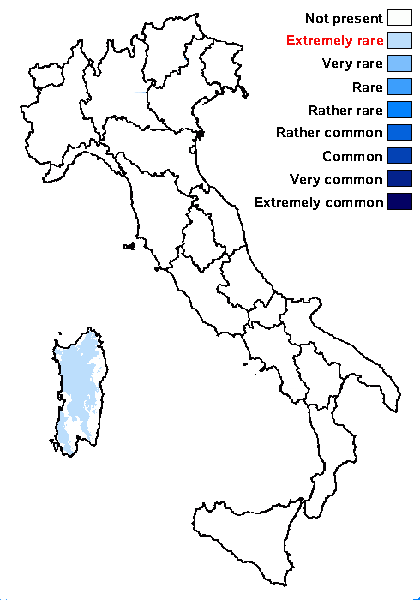Opegrapha phlyctidicola (Vouaux) Etayo
Bull. Soc. linn. Provence, 47: 103, 1996. Basionym: Celidium phlyctidicola Vouaux in Pitard & Harmand - Bull. Soc. Bot. France, 58, Mém. 22: 70, 1911.
Synonyms: Arthonia phlyctidicola
Distribution: C - Sar (Zedda & Sipman 2001, Brackel 2016)
Description: Thallus inapparent, not lichenized, the hyphae developing inside the thalli of Phlyctis-species, especially P. agelaea. Apothecia rounded to ellipsoid, 0.25-0.4 mm across, black, epruinose, with an expanded, flat disc. Epithecium brown-black; hymenium colourless; paraphysoids coherent; hypothecium colourless to pale brown. Asci 2-3(-4)-spored, fissitunicate, with a distinct apical dome around an ocular chamber. Ascospores (4-)7-8(-9)-septate, at first hyaline but turning brown when overmature, spindle-shaped, 24-30 x 5.5-6.5 μm. Photobiont absent. Spot tests: K-, C-, KC-, P-. Chemistry: without lichen substances.Note: a lichenicolous fungus growing on Phlyctis argena. The identification of the Sardinian samples, by R. Sundin, is not certain, as the specimen has unusually small spores.
Growth form: Lichenicolous fungus
Substrata: bark
Reproductive strategy: mainly sexual
paras Phlyctis argena
Commonnes-rarity: (info)
Alpine belt: absent
Subalpine belt: absent
Oromediterranean belt: absent
Montane belt: extremely rare
Submediterranean belt: absent
Padanian area: absent
Humid submediterranean belt: extremely rare
Humid mediterranean belt: absent
Dry mediterranean belt: absent

Predictive model
Growth form: Lichenicolous fungus
Substrata: bark
Reproductive strategy: mainly sexual
paras Phlyctis argena
Commonnes-rarity: (info)
Alpine belt: absent
Subalpine belt: absent
Oromediterranean belt: absent
Montane belt: extremely rare
Submediterranean belt: absent
Padanian area: absent
Humid submediterranean belt: extremely rare
Humid mediterranean belt: absent
Dry mediterranean belt: absent

Predictive model
 Index Fungorum
Index Fungorum
 GBIF
GBIF

